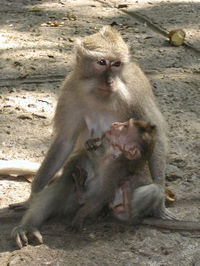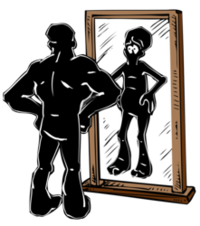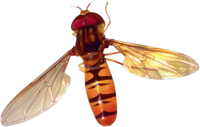Morning Sickness and Breast Cancer

Morning sickness has always been a puzzle and there are almost as many theories as there are sufferers.
Amongst some of the most popular theories are:
- An increase in the circulating level of the hormone estrogen. Estrogen levels may increase by 50-100 fold during pregnancy
- Low blood sugar during the early phases of pregnancy
- An increase in progesterone relaxes the muscles in the uterus, which prevents early childbirth, but may also relax the stomach and intestines, leading to excess stomach acids
- An increase in human chorionic gonadotropin
- An increase in sensitivity to odors, which in turn overstimulates normal triggers to nausea
I have always been interested in the idea that it is a device to protect the baby from dietary toxins. This theory was expressed very eloquently by Margie Profet, who suggested that eating vegetables may also be a factor. Vegetables produce a small amount of toxins to deter insect infestation and while these toxins are normally harmless to adult humans, they are potentially dangerous to the baby. It is also impressive that morning sickness is usually at its worst in the first trimester, when the baby is extremely sensitive to many kinds of toxins. It would be nice if Margie’s theory turns out to be correct. She was largely ignored by specialists in reproduction because she was not one, and a the time did not have an advanced degree.
So I was very interested to see some research from the University of Buffalo that was presented last week at the Society for Epidemiologic Research’s Annual Meeting in Boston. The epidemiologists found that women who had morning sickness may have a 30 percent lower risk of developing breast cancer later in life than mothers-to-be who went through pregnancy without any nausea.
The study was based on data from participants in the Western New York Exposure and Breast Cancer Study, a population-based case-control study of breast cancer conducted in women 35-79 from two Western New York counties between 1996 and 2001.
The analysis compared extensive data on pregnancy-related conditions from 1,001 women with primary breast cancer and 1,917 women without breast cancer matched to cases by age and race who served as controls.
The data presented suggest that the lower risk of developing breast cancer observed with nausea and vomiting was stronger as the symptoms became more severe, or persisted longer into pregnancy. A modest trend toward increased cancer risk was seen in premenopausal women who gained more than 40 pounds during pregnancy, compared to those who gained less than 23 pounds but the trend did not reach statistical significance.
Perhaps the link has to do with sensitivity to estrogen.
But the other possibility is that the nausea and vomiting not only expel toxins that may harm the baby. but also toxins that may eventually increase a woman’s risk of breast cancer. And why might three months of vomitinj make the difference?
Because one of the reasons for weight gain during pregnancy is a subtle change in the intestinal absorption of certain nutrients that the baby needs.
The Development of Color Vision

Last year we looked at the research suggesting that the reason why primates developed color visions was so that they could pick up color changes on the faces and posteriors of other apes.
Now researchers at Ohio University have found that after primates evolved the ability to see red, they began to develop red and orange skin and hair.
As we discussed last year, humans, apes and Old World monkeys, such as macaques and leaf monkeys, all have trichromatic vision, allowing them to distinguish between blue, green and red colors. Primatologists have disagreed about whether this type of color vision initially evolved to help early primates forage for ripe fruit and young, to be able to red leaves among green foliage, or to tell the state of anger or arousal in other apes or to help them select mates.

Now a new study published online this week in American Naturalist by Ohio University researchers Andre´Fernandez and Molly Morris suggests that red-color vision evolved for non-social purposes, possibly foraging. But once developed, trichromaticism – i.e. three color vision – drove the evolution of red skin and hair through sexual selection.
Andre´Fernandez first began to question the strict correlation of food choice and color vision while studying howler monkeys in Costa Rica. He recently compiled data on the color vision, social and sexual habits and red skin and pelage (hair, fur and wool) of 203 different primate species.
The researchers then used a phylogenetic tree representing the evolutionary relationships among all the primate species under study to test hypotheses about the order in which the traits of red color vision, gregariousness (highly social behavior) and red coloring evolved. By comparing the traits of individual species in this evolutionary context, Fernandez and Morris could use statistical methods to deduce the probability of their ancestors having the same traits. They could also see if any of the traits were correlated with one another.
They found that the species that could discern red and orange hues were more likely to develop red and orange skin and hair, as well as highly social habits that make it easier to visually compare mates. In fact, the more social the three-color vision apes are, the more red coloring they show.
Fernandez said,
“Neuroscience research has found some evidence of a perceptual bias for more brilliant colors, so it is reasonable for primates with trichromatic color vision to respond more when they see bright colors.”
Molly Morris, the co-author on the paper is a fish biologist who studies how physical traits such as coloring evolve through sexual selection.
She said,
“It looks like red skin and hair became a sexual preference, so while the benefits in terms of eating may not apply anymore, the (red-color) vision in some groups is now relevant in social terms.”
So while foraging may have initially sparked red color vision, the new ability was likely “recruited” for social purposes.
This is not just an interesting little evolutionary tidbit. There are plenty of systems in the human brain that evolved to do one thing, and are now used for something quite different. And sometimes these new uses conflict with some of the other programs running in the brain. This is likely to be one of the causes for some types of psychological problems. when the brain is trying to do too many things at once, and there is an imbalance between the older limbic regions of the brain and the cerebral cortex.
Genes, Geography and Culture

The science bug bit me early in life. As a young schoolboy I was fascinated to read the exploits of explorers and collectors. Charles Darwin’s amazing adventures were stirring stuff to a teenager.
The other day I was thinking about all those books that I read after I spotted an interesting article in the Daily Telegraph by Professor Steve Jones, who is a geneticist at University College London, and someone who always makes you think.
Bob Geldof – he of the Boomtown Rats and Live Aid fame – has set up an ambitious project to map cultural differences around the globe before the peoples of the world sacrifice their cultural individuality on the altar of Western consumerism, blue jeans and cell phones.
Anyone who travels as much as I do cannot help but be dismayed at the cultural homogenization that’s happened over the last 25 years. A bit jet lagged, I once woke up in a hotel in the wee small hours and called the front desk to ask which country I was in. I had been in seven in the last two days and there were no clues as to my location when the chauffeur dropped me off just before midnight. It turned out to be Switzerland and the man at the desk told me that it was a common question.
Although I lament the loss of cultural identity, it is not all bad. But it raises some very interesting questions.
While Bob is recording vanishing cultures, geneticists are trying to establish which behavior is determined by DNA and which by our environment.
Steve Jones was meditating on the question of whether local changes in customs inborn or learnt. My schoolboy hero Darwin was also interested in that question and set out to discover whether expressions of fear or joy varied from place to place. The idea was that they might if they were passed on culturally rather than genetically. He corresponded widely on the subject and Steve reminded me of something that I had not read in 30 years:
“Mr. B F Hartshorne… states in the most positive manner that the Weddas of Ceylon never laugh. Every conceivable incitive to laughter was used in vain. When asked whether they ever laughed, they replied: ‘No, what is there to laugh at?”
Darwin finally concluded that expressions of happiness or anger were universal. They had, he thought, evolved, because he fancied that he could detect hints of human laughter in the grin of a tickled chimpanzee.
Some behaviors have a genetic basis. The absence of cheese and milk from Chinese cuisine is normally attributed to the few cows in the country, or the influence of traditional Taoist notions of what items may appear in the same space. But it may have just as much to do with the high rates of lactose intolerance amongst Chinese populations. The Scots have a high frequency of a gene that makes it easier for them to digest cows’ milk, so milk – sometimes cleverly disguised – seems to appear on almost every Scottish menu.
There is an interesting sidebar here. A recent study that analyzed DNA in Neolithic human remains seems to have uncovered the first direct evidence that modern humans have evolved changes in response to natural selection.
According to a new analysis of fossilized bone samples, as recently as 7000 years ago, Europeans were unable to digest milk. Today more than 90% of the Northern European population can. It is most likely that Europeans incurred a rapid change in their genetic make-up because it held an evolutionary advantage for them to be able to digest milk.
Lactose is a sugar in milk, and around the world the majority of humans lose the ability to digest it before reaching adulthood. This is because their gene for the enzyme lactase, that is responsible for breaking down lactose, is switched off by late adolescence. However, over 90% of northern Europeans have a version of the lactase gene that remains active throughout life, enabling them to continue drinking milk as adults. This genetic change appears to have happened around 7,000 years ago and spread rapidly. In the climatic conditions of the time, milk drinking could have conferred a huge survival advantage: unlike water, milk in usually uncontaminated by parasites, and is available year round, unlike seasonal crops. Milk also contains vitamin D and calcium, and in the dim sunlight of Northern Europe, where people may not be able to make enough vitamin D in their bodies, making calcium absorption difficult. Milk would have solved both problems.
So what we might be seeing here is an environmental factor changing gene expression, which in turn has a social and cultural outcome.
Steve Jones’ article talks about some other cultural differences that may have genetic roots. One very recent study purports to show that the number of sexual partners of American male (but not female) college students is related to variation in a gene called dopamine transporter gene (DAT1). The gene codes for a dopamine transporter protein that limits the level and duration of dopamine receptor activation. It is a strong candidate gene for reward-seeking behavior. Dopamine is known to be involved in the reward or “salience” systems of the brain and is known to influence sexual behavior in mice.
The DAT1 gene comes in two distinct forms. Young men with a single or double copy of one of the variants have, it is claimed, twice as many sexual partners on average as do those with a double hit of the different and less common form of the gene. The latter group, about one young man in 10, are far less romantically daring than average. They are also less likely to be involved in drug abuse or to get in trouble with the law. Research like this is complex. To quote Gregory House, “People lie.” And when it comes to doing research on sexual behavior they lie a lot. And it is a fool’s game to try and reduce human behavior to a single gene. I am sure that if you think about it for a moment, you can come up with at least a dozen reasons why people are likely to have more sexual partners.
Levels of promiscuity vary greatly from place to place. There has been a myth circulating that the AIDS pandemic in Africa is caused by promiscuity. In fact there is less promiscuity in Africa than in the West. It is no surprise that young people less sexually active in Bangladesh than in Britain. For years now, anthropologists have speculated about what lies behind these variations, from the wild and socially sanctioned polygamy of a few males in certain ancient – and some not so ancient societies to the modern Western practice of serial (and approximate) monogamy. Recently researchers have begun to ask whether the differences might be due to genetics rather than the ownership of land or cattle, or social or religious mores.
The American DAT1 study shows that although DNA might have a strong effect on the behavior of individual men, it is unlikely to be responsible for cultural differences in sexual behavior. The students in the study were classified as of European, Black, and Asian or Hispanic origin. There are problems about racial classification: few are clear-cut. We are most of us far more mixed than some people would like to believe. The overall frequencies of the two variants were roughly the same within each ethnic group; and within each seemed to have the same effect. The Asian Americans, though, had fewer than half as many partners compared with the others. Social differences, that were most likely imported by their families from the sexually restrained populations of their native lands, overwhelmed any effects of the DNA.
For anyone interested in the complex interactions of genes, the environment, the psyche and culture, this study is yet another nail in the coffin of genetic determinism: that you are the victim of your genes.
Most mice and chimpanzees behave in much the same way from place to place. Yes, there are some subtle differences here and there, but as a general rule, and English mouse and a Chinese mouse will behave in much the same way. But humans show enormous cultural variation. But here is the paradox: at the genetic level we are the most boring of creatures. Yes, there is some genetic variation form place to place, and certain genes are more active, depending on environmental and cultural factors. Just think milk drinking and skin color. Human social diversity is matched by genetic homogeneity: the overall DNA difference between an American and a Chinese is less than that between two groups of chimpanzees living 100 miles apart in Africa.
Though our cultures have evolved over the centuries, it an evolution of mind rather than genes.
Why Aren’t We Furry?

For years now, people have wondered why most humans have very little in the way of fur. I have just read about an interesting idea that I hadn’t seen before. The suggestion is that humans are hairless because Stone-Age mothers regarded furry babies as unattractive.
The article was written by written by Judith Rich Harris, the author of two controversial, but challenging and absorbing books: The Nurture Assumption and No Two Alike. The article is entitled “Parental selection: a third selection process in the evolution of human hairlessness and skin color” and was published in the journal Medical Hypotheses. The article just won the 2006 David Horrobin Prize for medical theory, which has been awarded annually and named in honor of Dr. David Horrobin, who was a renowned researcher, expert in biotechnology and founder of Medical Hypotheses, who died in 2003.
In the paper Rich Harris speculates that in Stone Age societies the mother of a newborn had to decide whether she had the resources to nurture her baby. The newborn’s appearance probably influenced whether the mother kept or abandoned it and therefore an attractive baby was more likely to be kept and reared.
Harris’ theory is that this kind of parental selection may have been an important force in evolution. If Stone Age people believed that hairless babies were more attractive than hairy ones, this could explain why humans are the only apes who don’t have a natural fur coat. She goes on to suggest that Neanderthals must have been furry in order to survive the Ice Age in more Northern Regions than the Cro-Magnons from whom we are descended. Our species would have seen them as “animals” and potential prey. So her final hypothesis is that Neanderthals went extinct because our human ancestors ate them.
It is certainly an interesting idea, but I need a bit more convincing. Humans, like most other mammalian species are hardwired to protect the young at all costs, and it difficult to imagine how many Stone Age Sophie’s Choices would have had to have been made to create a hairless species.
We may learn more from continuing research into the fate of the Neanderthals: did they die out, or, as the psychologist and writer Stan Gooch suggested, did we mate with them? Are modern humans not simply the children of Cro-Magnons, but hybrids of Cro-Magnons and Neanderthals?
The Biology of Beauty
When we think about the characteristics that make someone physically attractive most of us probably think that they are purely subjective and culture bound. But recent evidence suggests that this is not true.
In an astonishingly comprehensive study published in the Proceedings of the Royal Society B: Biological Sciences, Devendra Singh from the University of Texas at Austin has analyzed references to fictional beauties from modern times back to early Indian literature. He found that slimness of the waist was the most common term of praise from an author.
I found it very surprising that this association even seemed to hold in times when a more Rubenesque figure was in fashion.
But I think that the key is not the actual number of inches, but the ratio of waist to hips.I have commented several times that the waist to hip ratio is probably a better physical marker of health risk than body mass index (BMI). Though even this needs to be supplemented by other tests.
Professor Singh’s work has nothing to do with making value judgments, but is instead looking at some of the factors involved in mate selection and this work adds to evidence highlighting the role of the ratio between waist and hips in attracting a mate.
All the recent furor over the dangerously shrinking fashion model has again raised the question that although female waist size has become important in modern Western society and culture – and is likely a factor fueling eating disorders – it is not completely clear whether this waist obsession has always been the case.
In what can only be described as a labor of love, Singh has spent years examining representations of women through history, and in one study, he measured the waist-hip ratio of hundreds of statues from different eras.
In the most recent research, he looked at how "attractive" women were depicted in literature, analyzing more than 345,000 texts, mainly from the 16th to 18th centuries. While most of the writings were British and American, there was a small selection of Indian and Chinese romantic and erotic poetry dating from the 1st to the 6th century of the Christian era.
Singh had this to say: "The common historical assumption in the social sciences has been that the standards of beauty are arbitrary, solely culturally determined and in the eye of the beholder. The finding that the writers describe a small waist as beautiful suggests instead that this body part – a known marker of health and fertility – is a core feature of feminine beauty that transcends ethnic differences and cultures."
Other studies have found a link between a woman’s waist to hip ratio and her fertility which may offer some explanation as to why during evolution it became a factor in selecting a mate. The ratio, like breast size and smooth complexion, is partly under the control of estrogen, which is, of course, a key hormone in the maintenance of fertility.
There has been a great deal of work – and even more speculation – about why men and women are found physically attractive. The idea is that beauty is an indicator of genetic and developmental health. There is also some evidence that physically "attractive" people are healthier than less attractive people.
In 2004 Satoshi Kanazawa and Jody Kovar from the London School of Economics published an intriguing study in the journal Intelligence with the controversial title: “Why Beautiful People are More Intelligent."
The basic idea is that evolutionary processes have, both genetically and socially, led to what we call assortative mating, in which partners have been chosen for their strength, good health and even height: all attributes which have given their possessors a high status. I must be honest that even though I’ve seen the data, when I see and hear some of the comments of a few people in the public eye I still question the association between beauty and intelligence.
There appear to be a few features that characterize physically attractive faces: bilateral symmetry, averageness, and secondary sexual characteristics. Attractive faces tend to be more symmetrical than unattractive faces.
Fluctuating asymmetry (FA) – random differences between the two sides of the face – is usually not found to be attractive. And this may be why: it increases with exposure to parasites, pathogens, and toxins during development. FA also increases with genetic disruptions, such as mutations and inbreeding. Developmentally and genetically, healthy individuals have less FA and more symmetry in their facial and bodily features.
Across many societies around the world, there is a positive correlation between parasite and pathogen prevalence in the environment and the importance placed on physical attractiveness in mate selection. The theory is that in societies where there are a lot of pathogens and parasites it is especially important to avoid individuals who have been afflicted with them when they select mates.
Facial averageness in another feature that increases physical attractiveness: faces with features close to the population average are more attractive than those with extreme features. The evolutionary reasons for why average faces in the population are more attractive than extreme faces are not as clear as the reasons for why facial symmetry is attractive. Some current speculation is that facial averageness results from the heterogeneity rather than homogeneity of genes so that would mean that individuals with average faces are more resistant to a larger number of parasites. Therefore like FA, facial averageness may be an indicator of genetic health and parasitic resistance.
There is good data that infants as young as 2-3 months gaze longer at a face that adults have judged attractive rather than a face judged unattractive. And other research has shown that 12 month old infants exhibit more observable pleasure, more play involvement, less distress, and less withdrawal when interacting with strangers wearing attractive masks, than with strangers wearing unattractive masks. They also play significantly longer with facially attractive dolls than with unattractive dolls.
2-12 months is not nearly enough time for infants to have learned and internalized the cultural standards of beauty through socialization and media exposure. So the research data seems to suggest that the standards of beauty might be innate, rather than learned.
Even though there is all this evidence for a evolutionary and biological factors in beauty, it is a mistake to use such a simple model to try and explain away all of our partner preferences.
By the time that they leave high school, most people have grasped that physical attractiveness is an important first step in attraction, but after that becomes highly
subjective: delightful but not essential.
This work also fails to take into account the attractiveness of factors like radiance, humor, attention, attentiveness, energy, self-assurance, movement, grace and gesture.
Neither can it take account curiosity, presence, charisma, compassion and spiritual awareness. All of these can be extremely attractive, but are hard to explain on simple biological and evolutionary models.
And, by the way, all of these additional factors can be learned: whatever your weight and measurements, whether you are tall or less so and whatever your age.
You can learn to develop many of the things that genetics may have forgotten.
“Beauty awakens the soul to act.” –Dante Alighieri (Italian Poet and Philosopher, 1265-1321)
“Beauty is not in the face, beauty is a light in the heart.” –Kahlil Gibran (Lebanese Poet and Philosopher, 1883-1931)
Don’t Underestimate Your Attractiveness!

I wonder how many readers have ever been in a social setting and been a bit depressed by how good-looking everybody else seems to be? I’ve seen quite a number of people who by anyone’s standards were attractive individuals, but who were quite convinced that they were not.
At this point most proponents of pop psychology would jump in and say, “Well he’s got low self-esteem and we need to fix that.” They would probably recommend some exercise involving a mirror and telling him or herself how beautiful, attractive, valuable or special they are.
And they would be dead wrong.
This misperception about the attractiveness of other people is an evolutionary trick that will not be much helped by any number of affirmations.
A very interesting and well-executed study from the University of Texas will be published in next month’s issue of Evolution and Human Behavior. Sarah Hill, a psychologist in David Buss’ evolutionary psychology laboratory. Her research has shown that people of both sexes believe that the sexual competition that they face is stronger than it really is. She beieves that this is useful: it makes people try harder to attract or keep a mate.
What Sarah did was to show heterosexual men and women photographs of people. She asked them to rate both how attractive those of their own sex would be to members of the opposite sex, and also how attractive the members of the opposite sex were. She then compared the scores for the former with the scores for the latter, seen from the other side. Men thought that the men they were shown were more attractive to women than they really were, and women thought the same of the women.
She had predicted the outcome of the study based on a theory developed in the same laboratory by Martie Haselton and David Buss. It is called error-management theory: the idea that when people make errors of judgment hey always tend to make the error that is going to be least costly. Research has shown something to which many women can attest: men often tend to misinterpret innocent friendliness as a sign that women are sexually interested in them. Haselton and Buss reasoned that men who are trying to decide if a woman is interested sexually could err in one of two ways. They can mistakenly believe that she is not interested, in which case they will not bother trying to have sex with her; or they can mistakenly believe she is interested, try, and be rejected. Trying and being rejected comes at relatively little cost. However, form an evolutionary perspective, not trying at all could lead the major cost of not being able to spread their DNA around.
The theory is that there is an opposite bias in women’s errors: They tend to undervalue signs that a man is interested in a committed relationship. The evolutionary argument would be that if she guesses wrongly about a man’s intentions, she might have to raise a child on her own.
However, when it comes to assessing physical attractiveness, man and women make the same errors.
We always need to be a bit wary about pushing the perspectives of evolutionary psychology too far. I think that they are valuable, but that we can get into trouble if we apply their insights too liberally: humans are complex creatures who are continuing to evolve rapidly. We are different in every way from the people of a thousand years ago.
But this is a very useful insight into why some many people feel to see themselves as they are.
The moral of the story: have courage in initiating new relationships, and look at the whole person: physical, psychological, social, subtle and spiritual.
And don’t forget to use your intuition: the surest guarantor of making the right steps in relationships.
“I never saw an ugly thing in my life: for let the form of an object be what it may, light, shade, and perspective will always make it beautiful.”
–John Constable (English Landscape Painter, 1776-1837)
Eye Color: An Instant Paternity Test?

Most of us learned some genetics in high school. You were probably taught about sweet peas, height and eye color. If mom and dad have blue eyes and little Johnny has brown, then mom probably has some explaining to do.
Sweet peas, height and eye color are examples of genetic determinism: genes determine outcome. But as I have written before, many other genes are not so simple: in behavior and metabolism genes do not so much determine behavior as how the person will react to the environment.
Now there is some fascinating new research about eye color published in the current issue of the journal Behavioral Ecology and Sociobiology.
The color of the human iris is determined by a simple, predictable and reliable genetic pattern of inheritance.
Investigators from the University of Tromso in Norway have shown that blue-eyed men find blue-eyed women more attractive than brown-eyed women. The researchers have postulated that there could be an unconscious male adaptation for the detection of paternity based on eye color.
At first blush this look like a bit of a stretch, but it may not be.
Let’s do a quick revision from high school genetics:
- If both parents have blue eyes, the children will have blue eyes.
- If both parents have brown eyes, a quarter of the children will have blue eyes, and three quarters will have brown eyes.
- The brown eye form of the eye color gene (or allele) is dominant, whereas the blue eye allele is recessive.
It then follows that if a child born to two blue-eyed parents does not have blue eyes, then the blue-eyed father is not the biological father. From an evolutionary perspective, males would be rather interested in knowing whether any children were theirs. So it is reasonable to expect that a man would be more attracted towards a woman displaying a trait that increases his “paternal confidence,” that any children would be his. If the mate also has blue eyes, it would be easy to uncover his partner’s sexual infidelity.
In the study, eighty-eight male and female students were asked to rate the facial attractiveness of models. The pictures were displayed on a computer screen and were close-ups of young adult faces of people who were not known to the participants. The eye color of each model was manipulated, so that for each model’s face two versions were shown, one with the natural eye color (blue/brown) and another with the other color (brown/blue). The participants’ own eye color was also recorded.
Both blue-eyed and brown-eyed women showed no difference in their preferences for male models of either eye color. Similarly, brown-eyed men showed no preference for either blue-eyed or brown-eyed female models. However, blue-eyed men rated blue-eyed female models as more attractive than brown-eyed models.
In a second study, a group of 443 young adults of both sexes and different eye colors were asked to report the eye color of their romantic partners. Blue-eyed men were the group with the largest proportion of partners of the same eye color.
The lead investigator – Bruno Laeng – had this to say, “It is remarkable that blue-eyed men showed such a clear preference for women with the same eye color, given that the present experiment did not request participants to choose prospective sexual mates, but only to provide their aesthetic or attractiveness responses…based on face close-up photographs.”
Blue-eyed men may have unconsciously learned to value a physical trait that can facilitate recognition of their own kin.
See if these findings ring true in your own relationships or in the people around you.
The Genetics of the Dancing Bees

When I was ten years old, I picked up one of my father’s old books. By the end of page one I was hooked, and I am sure that it was one of the pivotal points of my life that lead to my subsequent careers.
The book was the Dancing Bees: An Account of the Life and Senses of Honey Bee by Karl von Frisch. I still have it: my edition is now 51 years old, and showing its age.
The book may have faded but its brilliant ideas have not. In 1973, along with Nikolaas Tinbergen and Konrad Lorenz, Von Frisch won the Nobel Prize in Physiology or Medicine.
Honey bees are an ideal group of animals for studying behavior. When they are young, adult worker bees perform a number of tasks in the hive including caring for eggs and larvae. As they age, their job description changes and they shift to foraging for nectar and pollen. However, if the hive has a shortage of foragers, some of the young nurse bees will switch jobs early and go out foraging.
This job transition, whether it is triggered by age or social or environmental cues, involves changes in thousands of genes in the honey bee brain; some genes turning on, while others turning off.
The gene switching is achieved by short strings of DNA that lie close to and modulated each gene or set of genes. The strings serve as binding sites for particular molecules called transcription factors. When the correct transcription factor finds its the binding site, the accompanying gene may be switched on. If the transcription factor breaks away from the binding site, the gene is switched off.
New research funded by the University of Illinois and the National Science Foundation was published in two papers 1. 2. in this week’s Proceedings of the National Academy of Sciences. It used a new approach to try and understand the genetic underpinnings of some of this social behavior. Scientists have recently sequenced the genome of the honey bee, so the researchers’ strategy was to scan the binding sites of transcription factors known to function in the development of fruit flies from a single cell to an adult.
It is noteworthy that two of the researchers are computer scientists, showing us how often we need their help in designing and executing a lot of cutting edge research.
A computer algorithm that they wrote scanned nearly 3,000 genes. Statistical techniques were then used to investigate whether particular transcription factors correlated with genes that were turned on or off (what we call differentially expressed) between nurse bees and foragers.
The answer was the discovery of five different transcription factors that showed a statistically significant correlation with socially regulated genes. I sometimes wonder about the ponderous humor of some scientists: the five transcription factors – known, in fruit flies, to be involved in the development of the nervous system development, olfactory learning and hormone binding – have the names Hairy, GAGA, Adf1, Cf1, Snail, and Dri.
We also have another example of Mother Nature wasting nothing. Some of the same genes involved in the development of the nervous system of fruit flies are re-used for behavioral functions in adult honey bees. There are significant differences in the ways in which the honey bee and fruit fly genes are regulated. It is those regulatory processes that help to ensure that the genes end up producing honey bee behavior and not a fruit fly brain.
These findings suggest that honey bees may well turn out to be useful in elucidating the mechanisms by which social factors regulate gene expression in humans, as well as the effect of environmental factors on the expression of genes involved in social behavior.
There is every reason to believe that some of the same genes will be used in the human brain. The gene regulators will make all the difference in determining whether a bee becomes a nurse or a forager or a human becomes a sinner or a saint: they respond to a child’s environment, cognitions, attitudes, and perhaps even their spirituality.
If you are interested in a brief entree to the interactions between positive psychology and gene expression, together with some brief comments by yours truly, you may be interested to have a look here.
Brain Growth

Something strange happened to our ancestors. Between about 100,000 to 35,000 years ago, their brains began to grow enormously.
There have been many theories as to why this happened, from climatic change to a change in diet. Some foods contain chemicals that can stimulate the growth of neurons. And yes, there are also those who claim that some external agency caused the sudden growth of the brain, a la Arthur C. Clarke’s 2001: A Space Odyssey.
But what is exciting is that the growth in the brain may still be going on today.
It is clear that the brain is constantly changing. This growth, change, development and regression does not only occur during development, learning or aging, but also over generations. It is often said that the modern human brain is identical to that of Stone Age man, but that is almost certainly not true. If you were to meet a person from 5,000 years ago, they would probably seem quite unintelligent, because all the things that you have learned have stimulated your cognitive abilities. This stimulation also stimulates the formation of the brain. Recent studies of the genetics underlying brain development have shown that the human brain has changed significantly over the last few thousand years.
A study in the journal Science has taught us something new. The investigators studied the gene Microencephalin (MCPH). When the gene is active it causes a severe reduction in brain size coupled with mental retardation. Remarkably, despite this abnormality, there is an overall retention of normal brain structure and a lack of overt abnormalities outside of nervous system. The function of MCPH in healthy humans is less well known.
What makes this study interesting is the finding that the MCPH has changed during the past ~37.000 years, and that the spread has been fast: there has been a strong positive selection for this gene, indicating that the brain has continued to evolve even in more recent times. This is exceedingly important. I have many times emphasized that human beings are changing extremely rapidly.
There is no reason to assume that the evolution of the brain has stopped, and there is every reason for thinking that this gene is one of the mechanisms of change in response to the environment. It is now key to understand all the modulators of MCPH activity. Is it food, stress or environmental stimuli?
Another recent study in the journal Nature analyzed human chromosome 8, and looked specifically at two regions called the major defensin (DEF) gene cluster and MCPH1. The authors also speculated that these regions have played a significant role in the expanded brain size that can be observed through hominid evolution.
At the end of the article, the authors say something very interesting:
“The majority of the genes in the region of high divergence in distal 8p play important roles in development or signaling in the nervous system. Notably, the extremely large CSMD1 gene, which lies at the peak of divergence and diversity, is widely expressed in brain tissues. High regional mutation rates and positive selection are generally assumed to be distinct, but it is possible that the former may facilitate the latter by increasing the rate of appearance of potentially advantageous single, or interacting, alleles. It is intriguing to speculate whether the accelerated divergence rate of this region has contributed to the rapid expansion and evolution of the primate brain.”
For people who are less familiar with this kind of science-speak, let me translate. The study of chromosome 8 should open a whole new field of enquiry about what makes the human brain special. Comparing this region with DNA from other species and from early humans, we will be able to study the relative contribution of these genes to brain size.
Though size isn’t everything (!). The key is to understand the impact of changes in brain size and brain complexity on cognitive processes. In general, there’s a good correlation between intelligence and the volume and complexity of specific regions of the brain.
These new genes and their rapid – and continuing – spread is fascinating. But there are some other things that also differentiate the “naked ape” from other primates. One of the most striking is the large amount of fat that we have in out subcutaneous tissues and in our brains. We also have more of the excitatory amino acid glutamate in our cerebral cortices than chimpanzees or gorillas.
There is much more to be learned, but the consequences for understanding our origins and potential treatments for neurological illnesses are just stunning.
The Evolution of Handedness and Laterality
The evolution of bilaterality marked a great change in the organization of animals and to this day some illnesses are associated with disturbances of the normal balance between the two sides of the human body, most especially of the hemispheres of the brain. Presumably they would not occur if we were still arranged like jellyfish or sponges. But then we would probably not have become the species that we are without that great evolutionary leap forward.
A new report has shown that at the molecular level, the first signs of genes that are expressed asymmetrically are in the lowly sea anemone. What is even more extraordinary is that the same asymmetric genes found n the sea anemone can induce lateralization in the embryo of a frog.
This is of more than just academic interest: it tells us that the move toward lateralization was already present hundreds of millions of years ago, and primitive versions of some of the same genes in your body are also present in the simplest of organisms. This is incredible evidence for the oneness of life. There is also something else. Nature is economical: genes that are not needed are discarded. The fact that these lateralization genes have been around for such a long time indicates that they were critically important in our development. And disturbances of them may be important to this day.
The scientists doing the study have speculated that creatures with radial symmetry, like starfish, might have evolved from asymmetrical animals. I couldn’t help but remember the apparently strange speculations of Rudolf Steiner, who said that the essential form of humans was present hundreds of millions of years ago, and that other animals devolved from them. The idea was that sentience and spirituality did not just crop up with homo sapiens. but have been present since the beginning of time. Be that as it may, understanding more about the fundamental processes of lateralization will likely have important implications for understanding human evolution and disease.
“The wise man remembers that while he is a descendant of the past, he is a parent of the future.”
–Herbert Spencer (English Evolutionary Philosopher, 1820-1903)
“We are descended not only from monkeys, but also from monks.”
–Elbert Hubbard (American Editor, Publisher and Author, 1856-1915)
“As Aurobindo and Teilhard de Chardin knew, the future of humankind is God-consciousness…”
–Ken Wilber (American Philosopher, 1949-)






